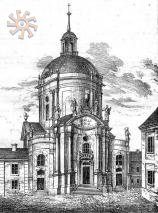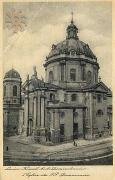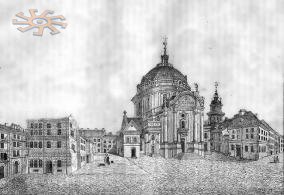 |
 |
|
|
|
|
The gravure with the image of a Dominican church of 1836. A modern view of an arch of a Cathedral from the Lviv High castle. A postcard with the view of a cathedral of times of German occupation. |
1. It was one of the first churches in Lviv (well, well - not this one, but its predecessor on the same place) - in ХІІІ-th century in Europe the Dominicans could legally carry a yellow jersey in competitions of numerous monastic orders. Only after appearance in XVI century of the Jesuits the position of the Dominicans was shacked. Therefore it is not surprising, that the Dominicans were the first of all Catholic monks, who appeared in the West Ukrainian territories and undertook the missionary work zealously. That was in Kamenets and that happened in Lviv where they had been invited by Constance, the wife of the prince Lev (according to the Polish sources it happened in 1234). After Dominicans the Franciscans would come, their temple’d appear during the last years of XIV century.
2. The initial temple (of the Divine body), reared on eastern uptown, was wooden, constructed most likely in 1290. It is known, that in 1407 it burnt down, and soon on its place on money of Nicholas Benko and Ann from Zabokruk the construction of two-naved Gothic temple in so-called "Kazimirskij style" under the direction of architect Nichka (Nicholas) Czech from Krakow began. As in a case of each Gothic cathedral, it lasted more than one decade, being sometimes rummaged through a lack of means or epidemic of wholesale deaths, and sometimes of fire (as in 1511). At that time cells and economic premises for the Dominican monastery were built. The cathedral should be huge as the monastery (more than hundred monks) was huge also. It is unknown for sure how it looked, except such details, as indispensable signature on a roof and elongated presbiterium. From the time of a Gothic cathedral the black crucifix from the main altar and a figure of Our Lady of Jackow from alabaster (XIV century, now remains in Krakow) have remained. 
3. Since 1458 all Ruthenian Dominican kostels were part of the Polish province of the order, and since 1612 the Lviv monastery became the “main” in Rus province of the Dominicans. In the end of XVI century 5 villages belonged to the kostel. In 1556 master Grygier built the library house, and in 1590 a new Dominatorium appeared.
4. After a fire in 1511 the temple was restored by archbishop Bernard Vilchek - and what, in 1527 a sacred place burnt down again - together with all Gothic Lviv.
5. In 1742 the church arch got tired and decided to fall. Experts decided that a construction can not be saved any more - and a cathedral was disassembled in 1749. Five alabaster gravestones in mannerism style remained (among others of Waclaw Dzeduszitcki, 1584; Jan Swoszowski, 1604; Stanislav Vlodek, 1615) plausibly of Herman Hutte as a souvenir. 
6. Monks had decided to build such a new temple to everyone understood: the main "office" of one of the pivotal monastic orders was before them. In 1749 Józef Potocki, the Hetman wielki koronny and the main founder of the building, solemnly pawned the first stone in the basement of the future cathedral. (In 2 years during the coronation of the local image of the Mother of god, Józef Potocki again would show, what means to chuck money around, having presented for an icon a gold crown and a frame). The headman of Kaniv also assisted with money.
7. Here this highly respected Mother of god Jackow executed in the Byzantian manner, according to a legend it came to Lviv from Constantinople - through Kyiv and Galich. And actually it was created in XV or XVI century in Venice or on Crete. As in 1751 the new temple was still in the process of construction, coronation take place on suburban meadows. 
8. There is another chance to recollect Kamenets! The commandant of Kamenets fortress, military engineer Johan de Witt was the creator of the project of the baroque miracle, a new Dominican cathedral. And it’s to be said, that it is difficult to find more refined sample of an epoch of late Baroque in Galicia. The creator planned his brainchild around the main carcass in the form of an ellipse which decorates a huge dome which is supported by eight pairs of columns - this green cap is well visible from all high points of Lviv. An altar and narthex are rectangular. The central nave is surrounded with radially located chapels.
9. Till 1764 the construction was performed under the control of Martun Urbanic then he was changed by Christopher Muradowicz. The facade was being decorated during the period of 1792-1798 by Klemens Fesinger. It was well done, expressive and dynamical. Experts say that the influence of Austrian architect Fischer von Erlach is felt here. It's not for nothing that a temple from time to time is compared with the St. Charles Boromeusha's church in Vienna. In 1764 a family chapel of Potocki under the title of Jackow's Mother of god was built. At that time the archbishop of Lviv Vaclav Хhieronim Serakovskij consecrated just a new erected temple. 
10. The interior amazes with greatness and solemnity. The high-rise space grows dynamically. It’s the successful architect's decision. Necessarily come here if not to hear an organ music concert, then on liturgy (in 1997 in a kostel the Greco-catholic church of St. Eucharist was settled). An interior is decorated with 18 wooden rococo carved sculptures of the Dominicans who have made their way up to rank "sacred". Sculptures are created by the Lviv masters of the second half of XVIII century (other data points that all sculptures were created by Sebastian Fesinger). The high altar is decorated with four figures of apostles (1775-1777) performed by Matthew (or Peter?) Poliyovskij. The project of the high altar was executed by M.Urbanik (1766). Formerly from apex of dome the Foucault's pendulum hanged down - the atheism museum was situated in a temple.
11. The monastery was not always the lucky one. The baroque miracle burnt (in 1766 and in 1778) twice, and even the second fire was extremely shattering. The whole command of architects, among other Jan Obrotskij restored a complex, and the monastery itself had the group of carvers and fixers. 
12. In 1772 75 monks - 38 chaplains, 25 brothers and 12 clergymen lived in a kostel. The monastery had the luck not to fall under/avoid the secularization adopted by Austrian king Józef. It must name among the most valuable relicts of the Austrian day the gravestone Józef Borkovsky (1811) of St. Dominic Chapel, the art of the great (Albert) Bertel Thorvaldsen. During the Austrian power a bell gable of the temple appeared (1865, the architect J.Zaharewicz). Restorations of a complex and its interiors (1885-1914) were performed repeatedly. However, it is said that the relic lost a lot because of those renewals: the coloristic of walls changed from white to off-white, a pseudo-alabaster plinth appeared and what is the worst of all, the green rococo carvings of the sacred were gilded. The high altar was replaced by a stucco (?) copy. Some neorococo altars and an ambon appeared. A new small lamp on a dome was not also similar to its predecessor - octagonal.
13. The Dominicans managed their kostel till the Second World War. It is known that during the interwar period almost all bohemia of Lviv went there. Then the Museum time came. It was almost the best museum of such specialization in the USSR. The museum from which name a word "atheism" was deleted and in which name a word combination of "religion histories" was inserted, functions in monastery cells (How long? Churchmen repeatedly encroached on these premises, and the museum library WAS simply thrown out (!!) - And now books are in a cellar). The organ was decided to be transferred on choir. It’s the same as to kill the tool... Not for nothing I so hate the religion and its "figures".
So I’m telling about the museum. I very very Very much recommend. Even if you are not interested in muslim’s whips for self-flagellation, bibles of XVI item or the Jewish silver pointers in form of palms for Torah reading, you’ll be amazed with pair burial of the Corded Ware culture. A clod of 5 tones was brought to the museum – it was afraid to damage by incorrect movement the harmony of love which is so expressively appreciable even now when these the man and the woman of about 35 years turned on skeletons. How could it be possible, how it is possible to die in embraces – they have no trace of violent death? Incredibly. Once this burial stroke me as a lightning. Though, probably, as all cynics, I am too sentimental.

1. In 1559 the monastery was fired from Powder tower by Lukash Gurcka, trying thus to entice from the kostel his fiancée unfortunate Galshka of Ostrog...
2. The inscription on a facade sounds so: "Soli Deo Honor et Gloria". Even my knowledge of Latin will be sufficient for translation: "The Holy One! Honour and glory for him". The similar inscription decorated and the destroyed Dominican cathedral in Petersburg.
3. Even if you were not in Lviv, you saw the Dominican church. Well, even if you are of soviet background and you (and let compulsorily) should see M.Dunaevsky's musical about musketeer with M.Bojarskij in a leading role. Before the Dominican church one of film scenes was filmed.
4. Besides before becoming an atheism museum during the Soviet times, the cathedral served as a storehouse for cement.
5. From great to ridiculous, from sacred to sinful is one step. Literally. Look attentively at bas-reliefs of the house opposite to a cathedral. No, it did not seem to you. The man has a penis in his hand. It is Onan, and the brothel, which the bas-relief decorates, was not ashamed at all of the close neighborhood with a church. And the church - was it ashamed :)?
6. Near to a cathedral - popular club "Ula". Follow the graffiti - and will find. :)
Translated by Dictum Factum (Kyiv) 
Old views of church - since 1912 till 1942. |
Engraving of 1847 from weekly Przyjaciel Ludowy. |
|
|

|

|
 |
|
"Замки і храми України" - некомерційний cайт, що підтримується фактично силами і ентузіазмом однієї людини. Допомогти проекту:
гривневий рахунок 4149 5100 9101 3567
євровий - 5168757402858452
Patreon
Ваш внесок допоможе не зневіритися в тому, що роблю вже 20 років. Дякую.
Екскурсійний супровід у мандрівці Кам'янцем-Подільським, Поділлям та Західною Україною в цілому: kamienczanka@gmail.com 
© All rights reserved.
Всі права на матеріали охороняються у відповідності до законодавства України.
Будь-яке використання матеріалів сайту можливе лише за попередньою узгодженністю |
Розробник 
|
|
|

